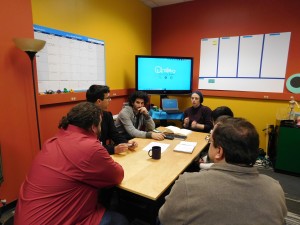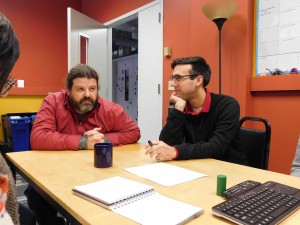 As quarters wrap up for this semester, many of the projects are just finding their feet and getting ready for the big push into delivering on their promises. While it’s a fundamental problem for design in general, for Aristeia in particular, that process was especially difficult and enlightening. Working with full family units is a difficult task, since the target demographic is essentially “anyone.” A woman with two boys, ages 3 and 12? A single father, his mother, and his 5-year-old autistic daughter? A brilliant 7-year-old boy and his hyper-involved parents? All valid. Plus, the museum is looking into really murky aspects of technology and design in the context of education. All of this together makes for a really exciting project, but one that is hard to get a handle on.
As quarters wrap up for this semester, many of the projects are just finding their feet and getting ready for the big push into delivering on their promises. While it’s a fundamental problem for design in general, for Aristeia in particular, that process was especially difficult and enlightening. Working with full family units is a difficult task, since the target demographic is essentially “anyone.” A woman with two boys, ages 3 and 12? A single father, his mother, and his 5-year-old autistic daughter? A brilliant 7-year-old boy and his hyper-involved parents? All valid. Plus, the museum is looking into really murky aspects of technology and design in the context of education. All of this together makes for a really exciting project, but one that is hard to get a handle on.
One of our strategies for dealing with this is direct observation within the space. So much of what they do is pretty uniquely tailored to their goals that it is hard to make sense of their work outside its own context. This has proven hugely informative, but it’s also a bit of a trap: if they have full-time learning scientists still unfolding the MAKESHOP’s success after several years on the staff, there is surely more to absorb than we can manage just from our own work. We needed a Reader’s Digest to supplement our exploration.
This led to outside research on our end as well as a long, hard look at the literature the museum had already produced, and, so girded, we felt much more comfortable attacking the problems the museum brought us in for.
Unfortunately, while this work was good and necessary for understanding the MAKESHOP as it currently stands, we had a second issue at hand: the space we were tasked with exploring was full of potential vagueness and conflicting definitions. What precisely is transmedia, for instance, and is that in fact what we’re being asked to introduce to the project? Or do they have something else in mind, for which there isn’t a word yet and “transmedia” was the closest any of us could find?
 After a few weeks of talking past each other in meetings, we were slowly honing in on a common understanding with our client about what our mission actually was, but with time ticking down and quarters only a few days away, we eventually had to cut the Gordian knot and ask them straight out. We gave our client contact a literal multiple-choice questionnaire with a couple alternative definitions of all our major objectives, and made her pick the best.
After a few weeks of talking past each other in meetings, we were slowly honing in on a common understanding with our client about what our mission actually was, but with time ticking down and quarters only a few days away, we eventually had to cut the Gordian knot and ask them straight out. We gave our client contact a literal multiple-choice questionnaire with a couple alternative definitions of all our major objectives, and made her pick the best.
It’s a bit awkward to introduce a mini-SAT to a client, but some deft conversational wrangling from our producer got us to a good point to hand it over, and the results were shockingly productive. She confirmed many suspicions, gave us some details we didn’t expect, and most importantly, landed on a common set of definitions so that we could all communicate clearly about our goals.
From the design side, though, I think it’s worth pointing out that the value of that questionnaire came out well before our client ever saw it. The team debated the questions fiercely, struggling to decide how best to communicate our intent at clarity. In doing so, we landed on a formula for our design problem, which runs something like:
“MAKESHOP practices are extensible to family learning, under X conditions.
MAKESHOP practices are extensible to transmedia spaces, under Y conditions.
These two things, and what MAKESHOP already does, interact in Z ways.
Solve for X, Y, and Z.”
Our client contact was very pleased by what we had cooked up, since we were able to verbalize now the ideas she had been trying to impart on us. The lesson we learned is that expecting definition is not enough; and, conversely, that time spent even only within the development team trying to hash out these meaning can be extremely productive.
- Written by Antonin Fusco
